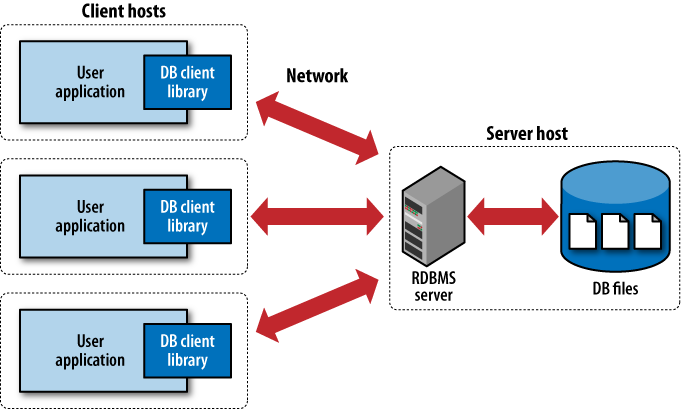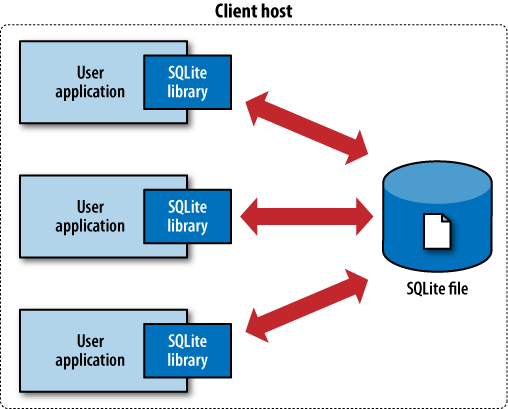Unlike most RDBMS products, SQLite does not have a client/server architecture. Most large-scale database systems have a large server package that makes up the database engine. The database server often consists of multiple processes that work in concert to manage client connections, file I/O, caches, query optimization, and query processing. A database instance typically consists of a large number of files organized into one or more directory trees on the server filesystem. In order to access the database, all of the files must be present and correct. This can make it somewhat difficult to move or reliably back up a database instance.
All of these components require resources and support from the host computer. Best practices also dictate that the host system be configured with dedicated service-user accounts, startup scripts, and dedicated storage, making the database server a very intrusive piece of software. For this reason, and for performance concerns, it is customary to dedicate a host computer system solely for the database server software.
To access the database, client software libraries are typically provided by the database vendor. These libraries must be integrated into any client application that wishes to access the database server. These client libraries provide APIs to find and connect to the database server, as well as set up and execute database queries and commands. Figure 1-1 shows how everything fits together in a typical client/server RDBMS.
In contrast, SQLite has no separate server. The entire database engine is integrated into whatever application needs to access a database. The only shared resource among applications is the single database file as it sits on disk. If you need to move or back up the database, you can simply copy the file. Figure 1-2 shows the SQLite infrastructure.
By eliminating the server, a significant amount of complexity is removed. This simplifies the software components and nearly eliminates the need for advanced operating system support. Unlike a traditional RDBMS server that requires advanced multitasking and high-performance inter-process communication, SQLite requires little more than the ability to read and write to some type of storage.
This simplicity makes it fairly straightforward to port SQLite to just about any environment, including mobile phones, handheld media players, game consoles, and other devices, where no traditional database system could ever dare to venture.
Warning
Although SQLite does not use a traditional client/server architecture, it is common to speak of applications being “SQLite clients.” This terminology is often used to describe independent applications that simultaneously access a shared SQLite database file, and is not meant to imply that there is a separate server.
SQLite is designed to be integrated directly into an executable. This eliminates the need for an external library and simplifies distribution and installation. Removing external dependencies also removes most versioning issues. If the SQLite code is built right into your application, you never have to worry about linking to the correct version of a client library, or that the client library is version-compatible with the database server.
Eliminating the server imposes some restrictions, however. SQLite is designed to address localized storage needs, such as a web server accessing a local database. This means it isn’t well suited for situations where multiple client machines need to access a centralized database. That situation is more representative of a client/server architecture, and is better serviced by a database system that uses the same architecture.
Get Using SQLite now with the O’Reilly learning platform.
O’Reilly members experience books, live events, courses curated by job role, and more from O’Reilly and nearly 200 top publishers.



